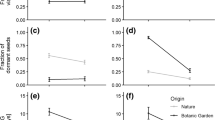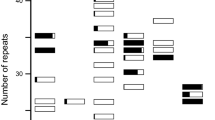Abstract
Three species ofAmaranthusare cultivated for their edible seeds:A. hypochondriacus L.,A. cruentusL., andA. caudatusL. The first two are native to Mexico and Guatemala, while the third originated in the Andes. Some authors recognize a fourth species,A. MantegazzianusPass. (A. edulisSpeg.), also from South America. Recent interest in amaranths as crops for improving Third World nutrition makes studies of relationships among amaranth species and intraspecific variation important. The weedy speciesA. hybridus L. (A. quitensisHBK) has been suggested as the progenitor ofA. caudatus, and it appears to be the closest wild relative of the crop. However, discovery of semidomesticated, darkseeded amaranths in Ecuador that are referable toA. caudatusraises some questions. The dark-seeded plants might represent a transitional form between the crop and its weedy progenitor, the product of independent selection of special forms ofA. hybridus, the result of introgressive hybridization between the crop and related weed, established escapes from cultivation, or remnants of the ancestor of the crop which may have been simply wildA. caudatusand notA. hybridus. Detailed morphological comparisons have been made among cultivated forms ofA. caudatus, the semidomesticate, andA. hybridus. Genetic data have been considered, and 2 mixed populations includingA. hybridusand the semidomesticate have been examined. Although all the other hypotheses cannot be eliminated, the dark-seededA. caudatusplants seem most likely to represent escapes from cultivation. Separate recognition ofA. Mantegazzianusdoes not seem warranted.
Similar content being viewed by others
Literature Cited
Callen, E. O. 1967. Analysis of the Tehuacan coprolites.In D. S. Byers, ed. The Prehistory of the Tehuacan Valley. Vol. 1: Environment and Subsistence, pp. 261–289. Univ. Texas Press, Austin.
Coons, M. P. 1970. The relationship of Ecuadorianquinoa de CastillaandAmaranthus caudatusL. Abstr. Proc. Indiana Acad. Sci. 80: 413.
—. 1975. The genusAmaranthusin Ecuador. Ph.D. diss., Indiana Univ. Univ. Microfilms, Ann Arbor, MI.
---. In press. The status ofAmaranthus hybridusL. in South America. Ciencia y Naturaleza. Covas, G. 1950. Un hibrido interespecifico natural en “Amaranthus.” Revista Argent. Agron. 17: 257–260.
Grant, V. 1971. Plant Speciation. Columbia Univ. Press, New York.
Gran, P., M. Aubertin, and A. Radlow. 1962. Multiple differentiation of plasmons of diploid species ofSolanum. Genetics 47: 1321–1333.
Hauptli, H. 1979. Germplasm resources and notes on the evolutionary origins ofAmaranthusin Central and South America. Paper presented at Second Amaranth Seminar of Rodale Press, Kutztown, PA.
Heiser, C. B., Jr. 1964.Sangorache, an amaranth used ceremonially in Ecuador. Amer. Anthropol. 66: 136–139.
Holmgren, P. K., and W. Keuken. 1974. Index Herbariorum. Pt. 1. The Herbaria of the World. Reg. Veg. 92. Oosthock, Scheltema and Holkema, Utrecht.
Hunziker, A. T. 1943. Las especies alimenticias deAmaranthus y Chenopodium cultivadas por los Indios de America. Revista Argent. Agron. 10: 297–355.
—. 1951. El nombre botanico del “chaclion.” Revista Argent. Agron. 18: 104–106.
—. 1952. Los pseudocereales de la agricultura indigina de America. Direc. Public. Univ. Nac. Cordoba, Cordoba.
—, and A. M. Planchuelo. 1971. Sobre un nuevo hallazgo deAmaranthus caudatusen tumbas indigenas de Argentina. Kurtziana 6: 63–67.
Khoshoo, T. N., and M. Pal. 1972. Cytogenetic patterns inAmaranthus. Chromosomes Today 3: 259–267.
MacNaughton, I. H., and J. L. Harper. 1959. The comparative biology of closely related species living in the same area. II. Aberrant morphology and a virus-like syndrome in hybrids betweenPapaver rhoeasL. andP. dubiumL. New Phytol. 59: 27–41.
MacNeish, R. S. 1967. A summary of subsistence.InD. S. Byers, ed. The Prehistory of the Tehuacan Valley. Vol. 1: Environment and Subsistence, pp. 290–309. Univ. Texas Press. Austin.
Marx, J. L. 1977. Amaranth: A comeback for the food of the Aztecs? Science 198: 40.
Murray, M. J. 1940. The genetics of sex determination in the family Amaranthaceae. Genetics 25: 409–431.
Pal, M., and T. N. Khoshoo. 1972. Evolution and improvement of cultivated amaranths. V. Inviability, weakness, and sterility in hybrids. J. Heredity 63: 78–82.
—, and —. 1973. Evolution and improvement of cultivated amaranths. VI. Cytogenetic relationships in grain types. Theor. and Appl. Genet. 43: 242–251.
Pickersgill, B. 1967. Interspecific isolating mechanisms in some South American chili peppers. Abstr. Amer. J. Bot. 54: 654.
—. 1971. Relationships between weedy and cultivated forms in some species of chili peppers (GenusCapsicum). Evolution 25: 683–691.
Sauer, J. D. 1950. The grain amaranths: A survey of their history and classification. Ann. Missouri Bot. Gard. 37: 561–632.
—. 1967. The grain amaranths and their relatives: A revised taxonomic and geographic survey. Ann. Missouri Bot. Gard. 54: 103–137.
—. 1969. Identity of archaeologic grain amaranths from the valley of Tehuacan, Puebla, Mexico. Amer. Antiquity 34: 80–81.
Schwanitz, F. 1966. The Origin of Cultivated Plants. Harvard Univ. Press, Cambridge, MA.
Smith, C. E., Jr. 1967. Plant remains.In D. S. Byers, ed. The Prehistory of the Tehuacan Valley. Vol. 1: Environment and Subsistence, pp. 220–255. Univ. Texas Press, Austin.
Solbrig, O. T. 1970. Principles and Methods of Plant Biosystematics. Macmillan, New York.
Thellung, A. 1914.Amaranthus. In P. Ascherson and P. Graeber, eds. Synopsis der mitteleuropäischen Flora 5: 225-356.
Tucker, J. M., and J. D. Sauer. 1958. AberrantAmaranthuspopulations of the Sacramento-San Joaquin Delta, California. Madroño 14: 252–261.
U.S. National Academy of Sciences. 1975. Underexploited tropical plants with promising economic value. National Academy of Sciences, Washington, DC.
Walton, P. E. 1968. The use ofAmaranthus caudatusin simulating breeding behavior of commercialGossypiumspecies. J. Heredity 59: 17–18.
Watson, P. J., and R. Yarnell. 1966. Archaeological and paleoethnobotanical investigations in Salts Cave, Mammoth Cave National Park, Kentucky. Amer. Antiquity 31: 842–849.
Whitaker, T. W., and W. P. Bemis. 1963. Virus-like syndromes ofCucurbitaspecies hybrids. Heredity 19: 229–236.
Author information
Authors and Affiliations
Additional information
This paper is based on a portion of a dissertation submitted in partial fulfillment of the requirements of the Ph.D. degree in the Department of Plant Sciences (now Biology) at Indiana University.
Rights and permissions
About this article
Cite this article
Coons, M.P. Relationships ofAmaranthus caudatus . Econ Bot 36, 129–146 (1982). https://doi.org/10.1007/BF02858709
Received:
Accepted:
Issue Date:
DOI: https://doi.org/10.1007/BF02858709




